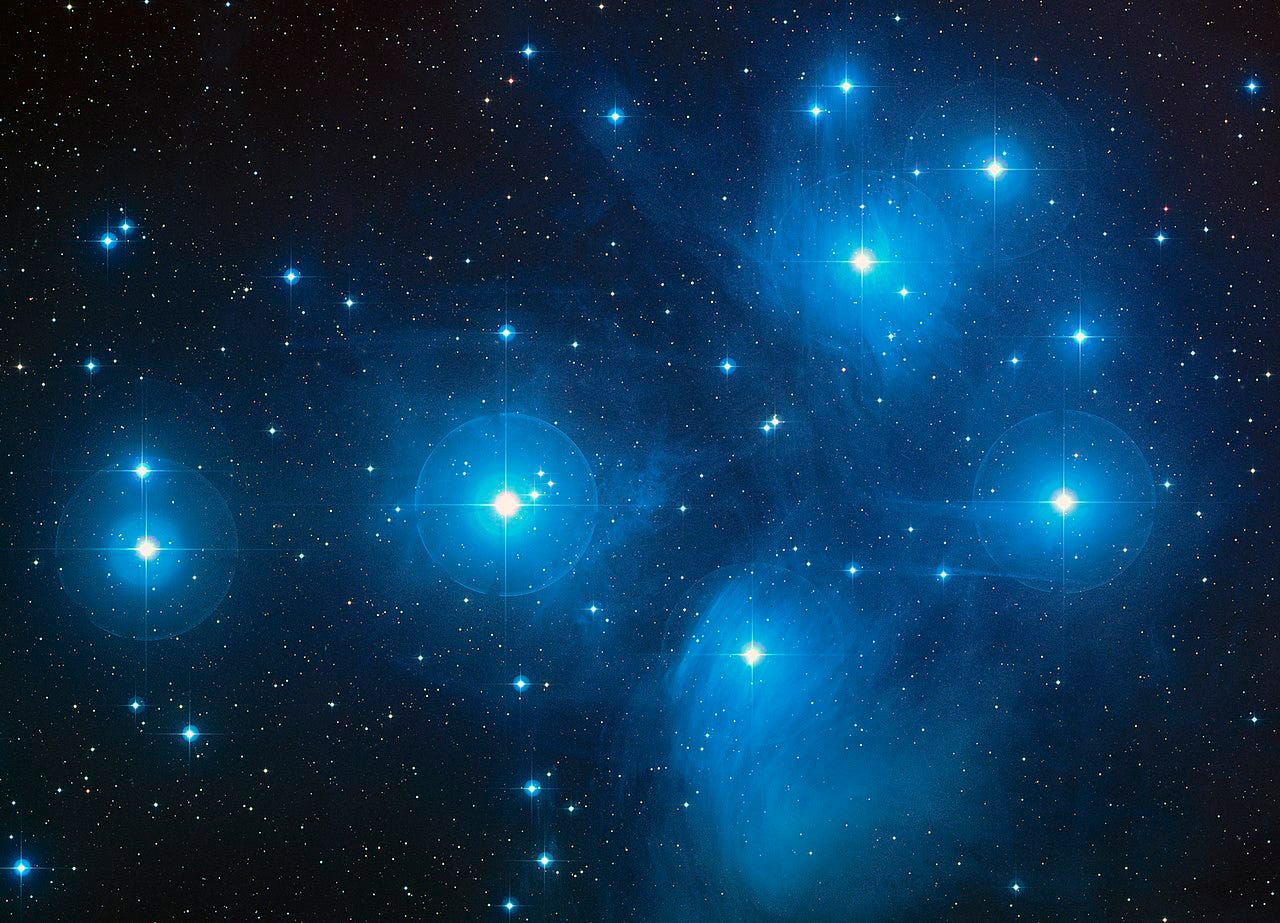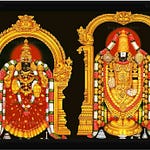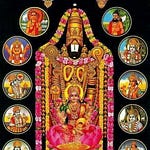In the previous verse (Atry-ādi), the Seven Sages descended from the heavens to wake up Lord Veṅkaṭeśa. In this verse are described the great gods who visit Tirupati in the morning for the dawn service (suprabhāta-sevā) of the Lord.
Pañcânanâ-’bjabhava-Ṣaṇmukha-Vāsavâ-’’dyās Traivikramâ-’’di-caritaṃ vibudhāḥ stuvanti | Bhāṣā-patiḥ paṭhati vāsara-śuddhim ārāt Śeṣâdri-śekhara-vibho! tava suprabhātam || (VSu 6)
पंचाऽऽनना-ऽब्जभव-षण्मुख-वासवा-ऽऽद्यास्त्रैविक्रमा-ऽऽदि-चरितं विबुधाः स्तुवन्ति । भाषापतिः पठति वासर-शुद्धिम् आरात् शेषाद्रि-शेखर-विभो ! तव सुप्रभातम् ॥
Five-headed Śiva, Lotus-born Brahmā, Six-faced Skanda, Indra, chief of the Vasus: All these gods and more stand praising Your miraculous deeds— spanning the universe in three steps and many more!— While Bṛhaspati, Lord of Speech, standing at a distance, proclaims the auspiciousness of the day. O All-pervading Almighty atop Śeṣâdri, a blessed morning unto You!
The names of the gods
The deities who are described in this verse are not called by their standard names, but by classic epithets that describe something particularly germane to this context.
Pañcânana (“the five-face(te)d one”): Each of the five faces of Śiva has a specific name (Īśāna, Sadyo-jāta, Vāma-deva, Aghora, and Tat-puruṣa), and is associated with a specific compass direction, one of five functions (pañca-kṛtya) of creation, maintenance, destruction, concealment and grace, and more.
When we think of “face” as really being “facet of reality”, the suggestion here is that all of these aspects and processes of the Divine unfolding are ways to worship Lord Veṅkaṭeśa.Abja-bhava (“lotus-born”): This name for Brahmā highlights his dependence on the cosmic form of Mahāviṣṇu: Brahmā is born from a lotus that emerges from the navel of Mahāviṣṇu. We can imagine this cosmic lotus blossoming due to the divine light of Mahāviṣṇu’s cosmic sun-face, just as in our world lotuses blossom with the sun’s light.
Brahmā is the creator of the world, but he does not stand independently of the Lord: instead, we see that the very creator of the world, not to mention the created world itself, are dependent on Lord Veṅkaṭeśa.
Ṣaṇ-mukha (“the six-face(te)d one”)1: This name for Skanda or Murugan can be interpreted in two different ways here.
As the son of Śiva and Pārvatī, Skanda has six faces combining his father’s five faces with his mother’s face (Śakti). The suggestion here is that all of these facets of reality celebrate and worship Lord Veṅkaṭeśa.
Skanda is also known as Kārtikeya because he was raised by six Kṛttikās, who can be seen in the sky as part of the Pleiades constellation.

A NASA-generated picture of the Pleiades constellation (Kṛttikā) from WikiMedia
Vāsava (“chief of the Vasus”)2: Of Indra’s many names, this one highlights his lordship and relation to the eight Vasus. While their exact names can vary by source, they are generally held to be the five elements (earth, water, fire, air and space), the sun, the moon, and the celestial sphere (or at least the Pole Star of this sphere, Dhruva).
Again the implication is clear: everything on earth and in the heavens above is coming together to celebrate the daily awakening of Lord Veṅkaṭeśa!
In keeping with all of these cosmic names for the deities, it is therefore also appropriate that the specific story of the Lord which is named here is His form as Trivikrama: the cosmos-spanning colossus who covered all of creation in but two steps (with His third step reserved for the head of King Mahābali).
What makes a day auspicious?
The third line of this verse can be interpreted in two slightly different, though celestially reconcilable, ways:
The first interpretation is that Bṛhaspati, the preceptor to the gods, is declaring the day to be an auspicious one—for all days and all moments are auspicious when we are in the presence of Lord Veṅkaṭeśa! Such a pronouncement, known as a puṇyâha-vācana “proclamation of a blessed day”, is a key element of every major Hindu ritual and requires the seeking of the blessings of elders. In this case, Bṛhaspati the preceptor is fulfilling this function.
The second interpretation is that Bṛhaspati is reading out (paṭhati) the day’s astronomical configuration, known as the pañcâṅga and comprising of five elements that determine the auspiciousness of a day as per the Hindu calendar.3 This ritual is most frequently done on New Year’s Day in most temples, but the implication here is that it happens every single day in Lord Veṅkaṭeśa’s presence.
The reconciliation of the two interpretations is also obvious: This recitation of the astronomical configuration of every single day in the presence of Lord Veṅkaṭeśa sanctifies every single day for His devotees. Note that this is not some kind of blind fate where immovable stars cast inalterable fates for helpless human beings: rather, whatever be the natural configuration, His name and His presence (sānnidhyam) sanctify all space and all time for His worship. In a way, the proliferation of temples to Lord Veṅkaṭeśa all around the world are testament to His accessibility to all, everywhere.
But what about everywhen? We will see this too shortly, in a connection between the Rāmāyaṇa and Lord Śrīnivāsa who is the eternal inseparable abode of Śrī.
|| Śrī-Padmāvatī-nāyikā-sameta-Śrī-Śrīnivāsa-parabrahmaṇe namaḥ ||
We see a similar reference to Skanda in Tŏṇḍar-aḍi(p)-pŏḍi Āzhvār’s Tiru(p)-paḷḷi-yĕzhucci dedicated to Lord Raṅganātha of Śrīraṅgam, as part of a description of the divine hosts congregating in Śrīraṅgam waiting to see Lord Raṅganātha open His lotus-eyes in the morning:
maruviya mayil-inan Aṟu-mugan ivanō (TPĔ 6b) மருவிய மயிலினன் அறுமுகன் இவனோ
Is this the Six-faced one, riding a cat’s-eye–iridescent peacock?
Indra is also referred to in the next verse of the Tiru(p)-paḷḷi-yĕzhucci:
Indiran ānaiyum tānum vand’ ivanō (TPĔ 7b) இந்திரன் ஆனையும் தானும் வந்து இவனோ
Is this Indra’s elephant Airāvata along with Indra himself who has come?
These five elements are, as per Hindupedia:
tithi: the day of the lunar month (itself treated as two pakṣas for the waxing and waning moon)
nakṣatra: one of the 27 lunar mansions
vāsara: one of the 7 days of the week
yoga: the angular separation between the sun and the moon, classified into 27
karaṇa: half of a tithi and 11 in number










Share this post